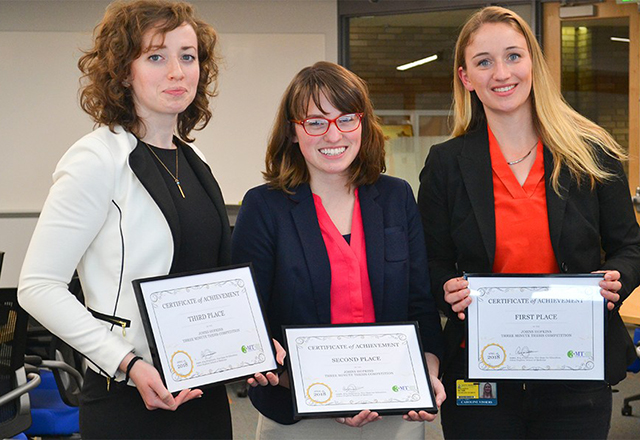Photo courtesy of hub.jhu.edu
Economics is defined, in practice, as the act of efficiently allocating scarce resources so as to best suit the wants and needs of humankind. In the context of a factory, this notion could refer to the efficient allocation of input commodities, such as steel and plastic, so as to maximize the production of an output, such as frying pans. However, economic principles can just as easily be applied to the allocation of intangible resources, such as words or images, so as to maximize the impact of ideas on an audience. In this way, the international Three-Minute Thesis (3MT) competition challenges Ph.D. students to take the economics of communication to the extreme. Contestants are tasked with delivering a talk on the significance of their dissertation topics, equipped with naught but a single PowerPoint slide and three minutes of stage time.
Following three preliminary heats, ten contestants from various schools of Johns Hopkins University (JHU) — including the School of Medicine, School of Nursing, School of Public Health, Kreiger School of Arts & Sciences, and the Whiting School of Engineering — coalesced on April 18 to present at a university-level semifinal competition, hosted by the JHU Professional Development and Career Office. The top two semi-finalists would proceed to the 3MT Competition for the State of Maryland on May 2nd. Although the various dissertation topics presented by this year’s competitors were quite diverse, there were a couple of strategies that the contestants commonly used to vividly communicate their ideas in the modest time available to them.
Almost all the contestants started off by illustrating a call to action on a particular issue, which would later be addressed by their thesis. Contestants did this in several different ways. For instance, Sarah Attreed (JHU School of Public Health) opened her talk by posing a hypothetical question, intended to illuminate a problematic situation. Before directly addressing how trace arsenic in drinking water inactivate influenza vaccines, Attreed questioned whether audience members would be surprised to find vaccine-inactivating constituents in drinking water. On the other hand, Tamar Rodney (JHU School of Nursing) showed an image of a man in anguish on her single PowerPoint slide to aid in her verbal call to action for research that focuses on the emotional aspects of patient care.
Contestants also deployed carefully orchestrated analogies to illustrate nontrivial concepts that were central to their dissertation topic. This strategy was frequently used to introduce a single main premise within the presentation before venturing into the more technical aspects of their dissertations. For instance, Joseph Rehfus (JHU Krieger School of Arts & Sciences) used the analogy of a disk to introduce how the same shape can appear vastly different when looked as from various angles, similar to the structural complexity seen in molecular structures of proteins. Interestingly, Caroline Vissers (JHU School of Medicine) used a cooking analogy to scaffold her talk. “Much like recipes can be transcribed from a cookbook and modified to produce a particular flavor,” she elaborated, “RNA transcribed from DNA can be modified to direct the differentiation of neural stem cells to produce particular ‘flavors’ of neurons during development.” Not only did Vissers consistently call back to the analogy throughout the duration of the talk, she used her allotted PowerPoint slide to clarify it by displaying a schematic diagram of her cooking analogy alongside a pathway of neural stem cells differentiating into different “flavors” of neurons.
Judges primarily assessed contestants based on audience engagement and the sharpness with which they described their dissertations. The combination of consistent verbal reinforcement and persistent visual reinforcement that Vissers used likely played a prominent role when both the judges and the audience decided to name her as the first-place semi-finalist and People’s Choice award recipient. Caroline Vissers was joined with second-place semi-finalist Valerie Rennoll (JHU Whiting School of Engineering), who spoke on the utilization of acoustic transducers for sensation of sound in robots, and the third-place semi-finalist Sarah Attreed at the Maryland State 3MT Competition. If you are interested in competing in next year’s 3MT competition, please contact Kate Bradford at 410-955-9877 or [email protected] at the JHU Professional Development and Career Office.
Related Content
- Bridging the Gap Between the Ivory Tower and the Public
- The Fate of Science Rests on Our Ability to Communicate
- The Mystery Behind the Jargon
- Want to take your science writing skills to a new level? We have a degree for that.
